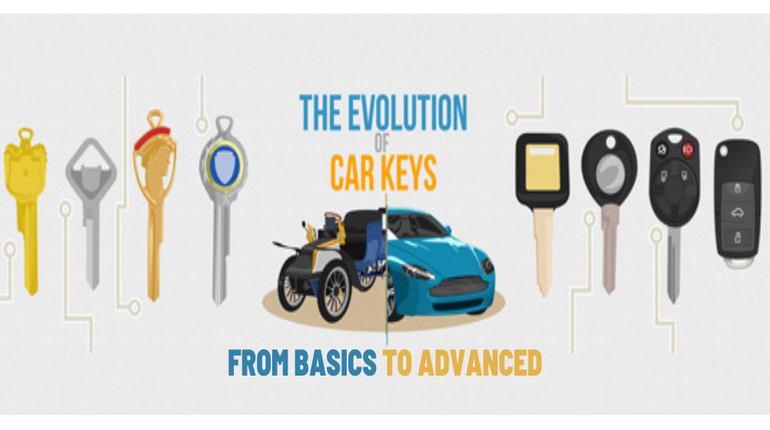Car keys have come a long way since the early days of the automobile industry. From simple mechanical keys to advanced biometric sensors, car key technology has evolved rapidly over the years, providing drivers with greater convenience, security, and functionality.
In this blog, we will take a closer look at the evolution of car key technology, from basic to advanced, and explore the various types of keys developed over the years.
So, whether you are a car enthusiast, a driver, or simply interested in the latest technological developments, this blog will surely provide valuable insights into the world of car key technology.
Talking about car key technology
Since the beginning of the 20th century, car keys have been a crucial part of the automotive industry. Simple mechanical keys were the original type of vehicle keys, and they were used to manually lock and unlock car doors as well as start the engine. Push-button ignition, electronic keys, key fobs, and even biometric sensors are now part of the technology.
With each new technological development, car keys have improved in security, convenience, and sophistication, enabling drivers to quickly and safely enter and control their automobiles. The development of key automobile technologies is advancing quickly, with breakthroughs and advancements being made every day.
However, one of the most common issues faced by car owners is the loss of car keys. It can be a frustrating and stressful experience, especially if it happens in a remote location or during odd hours. If you find yourself in this situation, it’s important to stay calm and assess your options.
The good news is that, with the evolution of car key technology, there are now various options available for replacing lost car keys. From simple mechanical keys to high-tech biometric sensors, car key replacement options vary depending on the type of key and the level of security required.
1) The early days of car keys: Mechanical keys
Simple mechanical keys were used in the early days of automobiles to lock and unlock car doors and start the engine. These keys were often made of metal and featured distinctive ridges and grooves that matched the lock mechanism on the respective automobile. For the door to be locked or unlocked or for the engine to start, the driver had to turn the key in the lock.
These mechanical keys were straightforward and trustworthy but also easy to copy and steal. Cars with mechanical keys were less safe than those with newer types of keys because auto thieves could quickly pick the locks or duplicate the key.
Despite this, mechanical keys continued to be the norm until better technologies were created.
2) The advent of electronic keys and Key fobs
Electronic keys and key fobs entered the picture as technology improved, which also affected automotive key technology. In the 1980s, the first electronic keys appeared.
These keys used a radio signal to operate. These signals were detected by a receiver inside the vehicle, enabling the doors to be unlocked and the engine to be started.
Features
- Electronic keys and key fobs use radio frequency identification (RFID) technology to communicate with the car’s computer system.
- They are more secure than mechanical keys because they use rolling codes that change each time the key is used, making it difficult for thieves to duplicate or intercept the code.
- Electronic keys and key fobs often have remote entry functions that allow drivers to unlock and lock their cars from a distance.
- Some electronic keys and key fobs have push-button start technology, which eliminates the need for a physical key to start the car.
- Some key fobs have additional features, such as a panic button, trunk release, and even remote start.
Today, most cars come equipped with key fobs that feature remote keyless entry, which allows drivers to lock and unlock their car doors without using the key itself. Keyless ignition systems, which allow drivers to start their cars with the push of a button, are also becoming increasingly common.
While electronic keys and key fobs offer greater convenience and security than mechanical keys, they can also be more expensive to replace if lost or damaged.
3) The rise of keyless entry and push-button ignition
The most recent advancements in automobile key technology include push-button ignition and keyless entry. Push-button ignition enables drivers to start their automobiles with the touch of a button, while keyless entry enables them to open and lock their car doors without needing the actual key.
These systems use a combination of RFID technology and proximity sensors to detect the presence of the key fob and allow access to the car. They provide greater convenience and ease of use for drivers, as they no longer need to physically handle the key to enter or start their cars.
Nevertheless, they have some drawbacks, such as the possibility of hacking and theft, as well as the requirement for regular key fob battery changes.
4) Smart keys and proximity sensors
The most recent developments in automobile key technology include proximity sensors and smart keys. Electronic and keyless entry technologies are combined with increased security and convenience in smart keys.
Smart keys employ a microchip to interact with the car’s computer system and enable push-button starting. Because of proximity sensors, they may also automatically open the automobile doors when the driver gets close to them.
Moreover, smart keys can offer several capabilities, including automated climate control settings, memory for the position of the seat and mirrors, and even remote engine starting. They also make it unnecessary for the driver to handle the key physically, lowering the risk of theft and facilitating entry to the vehicle in dimly lit or difficult-to-reach areas.
5) Biometric car keys: Fingerprint recognition and beyond
Biometric car keys take automobile key technology to the next level by using biometric data, such as fingerprint recognition or facial recognition, to authenticate the driver and allow access to the car.
Fingerprint recognition is the most common form of biometric authentication used in car keys. It allows the car to be unlocked and started only by the driver whose fingerprints have been registered in the car’s computer system.
Biometric car keys provide the highest level of security and convenience. They eliminate the need for physical keys or key fobs, and the risk of them being lost or stolen. Additionally, they can also be used to provide personalized settings for each driver, such as seat position, climate control, and infotainment preferences.
Car key replacement: Options and considerations
The loss of car keys is one of the most frequent problems experienced by automobile owners. Thankfully, there are now several choices available for replacing lost car keys thanks to advancements in auto key technology.
How to revamp used car keys?
Revamping used car keys is a great way to make them look and function like new again. An autolocksmith can help in revamping a used car key in several ways. Here are some examples:
- Rekeying: If you have lost your car key or need a spare, an autolocksmith can rekey the used key to work with your car’s locks. Rekeying involves changing the internal components of the key to match the lock’s configuration.
- Refurbishing: If your used key is worn or damaged, an autolocksmith can refurbish it by replacing the casing, buttons, or other components that are no longer functioning properly.
- Programming: Many modern car keys have electronic components that require programming to work with your car’s computer. An autolocksmith can program the key to work with your car’s system, ensuring that it can start the engine and lock and unlock the doors.
- Cutting: If you have a key that is worn or damaged beyond repair, an autolocksmith can cut a new key from scratch using your car’s locks as a template.
With the help of an auto locksmith, your used car key can be transformed into a like-new key that functions perfectly.
When to replace car keys?
It’s important to replace your car keys if they are worn, damaged, or no longer functioning properly. Signs that your keys need to be replaced include difficulty turning the ignition, a worn-out key blade, or a malfunctioning key fob.
You should also consider replacing your keys if you have lost or misplaced them to avoid the risk of theft or unauthorized access to your car.
How to Replace Car Keys:
To replace your car keys, first, determine the type of key you have and the type of replacement key you need. You can get a replacement key from your car dealership, a locksmith, or an online key replacement service.
It’s important to provide proof of ownership and identification to obtain a replacement key. Once you have the replacement key, have it programmed or cut to match your car’s specifications.
When replacing a lost car key, it’s essential to consider the level of security required, the cost of replacement, and the availability of replacement options. It’s also a good idea to have a spare key made and stored in a safe place to avoid getting locked out of your car.
Future trends in car key technology
As with all technological advancements, the world of car key technology is constantly evolving. Here are some of the future trends that we can expect to see in the coming years:
- Mobile device integration: Many car manufacturers are now exploring ways to integrate car key functions into mobile devices such as smartphones and smartwatches. This would allow drivers to use their mobile devices to lock and unlock their cars, as well as start the engine.
- Biometric authentication: Biometric sensors such as fingerprint recognition and facial recognition are becoming increasingly common in modern smartphones and other electronic devices. It’s not hard to imagine that car keys of the future could also incorporate biometric authentication, allowing drivers to access their cars using their unique biometric data.
- Vehicle-to-vehicle communication: As connected cars become more common, car keys could also incorporate vehicle-to-vehicle communication capabilities. This would enable drivers to share access to their cars with other drivers and even allow for automatic car sharing and carpooling.
- Advanced security features: With the increasing prevalence of car theft, manufacturers are also exploring ways to improve car key security. Future car keys could incorporate advanced security features such as encrypted communication protocols, multi-factor authentication, and even biometric authentication.
- Self-charging: Many modern key fobs require regular battery changes, which can be a hassle for drivers. Future car keys could be self-charging, using kinetic energy, or other renewable energy sources to power themselves.
- Augmented Reality: Augmented reality could also be integrated into car key technology. Imagine a scenario where drivers can use their car keys to get a live, interactive view of their car’s engine or other critical components, allowing for easier maintenance and troubleshooting.
Conclusion
The evolution of car Key technology and its impact on the automotive industry:
In conclusion, car key technology has come a long way since the early days of mechanical keys. From electronic keys and key fobs to keyless entry and push-button ignition, and now to smart keys and biometric sensors, car keys have evolved rapidly over the years, providing drivers with greater convenience, security, and functionality.
The evolution of car key technology has had a significant impact on the automotive industry, improving the safety and security of cars and enhancing the driving experience for drivers. As technology continues to evolve, we can expect to see even more advanced and innovative car key technology in the future.







